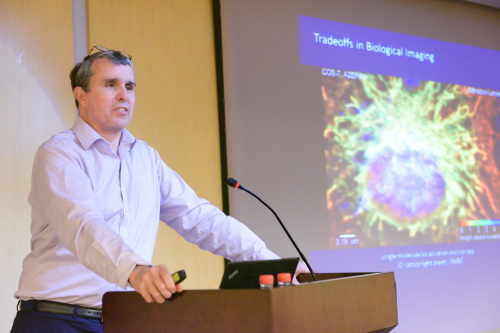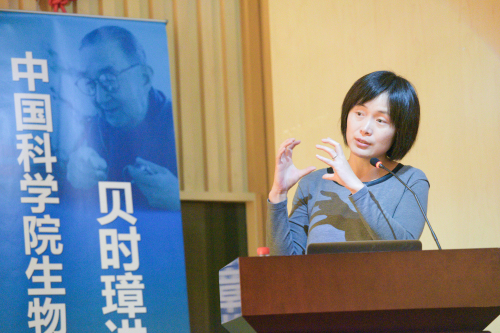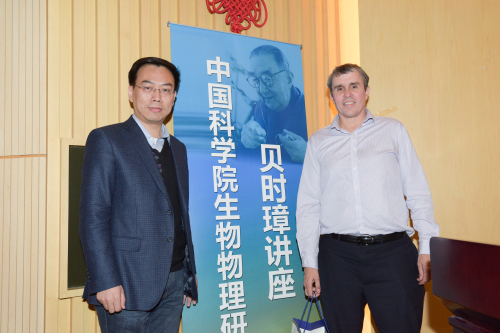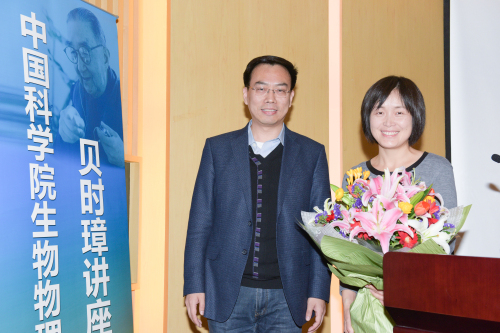Nobel Prize Winner Prof. Eric Betzig, and Na Ji from Howard Hughes Medical Institute Visited IBP and Delivered BEI Shizhang Lecture
Invited by the Prof. XU Tao, the Director General of the Institute of Biophysics, CAS, Prof. Eric Betzig and Na Ji from Janelia Research Campus, Howard Hughes Medical Institute visited the Institute of Biophysics (IBP) CAS, on March 15, 2016. Prof. Eric Betzig delivered the BEI Shizhang Lecture entitled Imaging Life at High Spatiotemporal Resolution, and Na Ji’s BEI Shizhang Lecture was entitled Wavefront Shaping for in vivo Brain Imaging. The lectures were hosted by Prof. Tao Xu. The PIs, research staff and students were so enthusiastic that the room was fully occupied.
Eric Betzig has been working in the field of developing fluorescence microscopy for a long time. He invented the photoactivated localization microscopy, which was recognized as a milestone of super-resolution microscopy development. Because of this contribution, he was awarded the 2014 Nobel Prize in Chemistry for "the development of super-resolved fluorescence microscopy". Nowadays, Betzig’s Lab develops novel optical imaging tools in an effort to open new windows into molecular, cellular, and neurobiology. In the lecture he pointed out that to gain a better understanding of how inanimate molecules assemble to create animate life, it is necessary to image the dynamics of living organisms noninvasively at high resolution in both space and time. However, there are inevitable tradeoffs of spatial resolution, speed, non-invasiveness, and imaging depth. He emphasized the recent development of super-resolution structured illumination microscopy, which they applied to study endocytic and cytoskeletal dynamics at the plasma membrane. This work was mainly accomplished by Dr. LI Dong when he was a postdoc in Betizg’s Lab, collaborated with Professor XU Pingyong in Institute of Biophysics. Then Eric Betzig introduced lattice light sheet microscopy, by which they imaged the rapid three-dimensional dynamics of single molecules in cells and embryos, as well as adaptive optics, which recovered the diffraction-limited optical resolution of two-photon microscopy in the highly aberrated brains tissues of zebrafish and mice.
Na Ji is a Group Leader of the Janelia Research Campus of Howard Hughes Medical Institute. Ji’s Lab focused on developing optical methods for in vivo imaging, and structural and functional studies of neural circuits. In the lecture, she said, aberrations and scattering in optical imaging lower the quality of imaging. Applying wavefront shaping to brain imaging was beneficial. She discussed how wavefront shaping techniques could achieve sharper, deeper, and faster imaging of the mouse brain in vivo. After that, she also introduced the recent advances on endomicroscopic techniques that allowed them to image deeply buried nuclei that were beyond the limit of image depth imposed by scattering in the brain.
After the reports, Eric Betzig and Na Ji answered the questions from the students in details and patiently, and had deep discussions with Prof. XU Tao, LI Dong and other researchers of the Institute of Biophysics.
The reports were ended with the warm applause from all the audience. Their courage of exploring unknown field and the spirit of fully dedication to academic research impressed and encouraged all the students, and they benefited a lot from the lectures. The visit of Eric Betzig and Na Ji brought new academic thought and opportunities for further cooperation, and propel the development of related research in the Institute of Biophysics, CAS.






